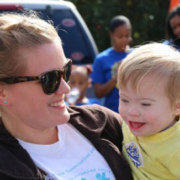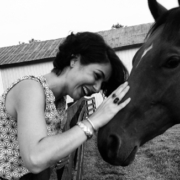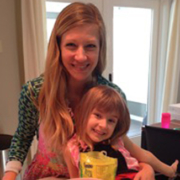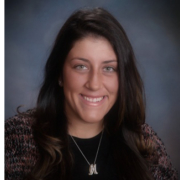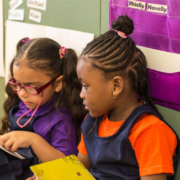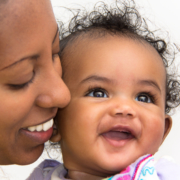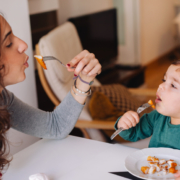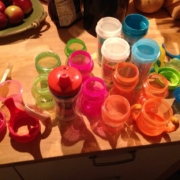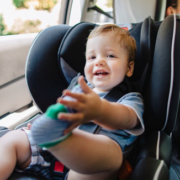Written by Foundling Guest Blogger, Stephanie Kearns, Vice President of Business Operations
In recognition of National Special Needs Month I’ll be sharing a series of blog postings about special needs and severe allergies with the help of peer parents who live with these fears or challenges every day.
Most people don’t know I had an older sister, Audrey, with special needs. She suffered with Cornelia de Lange syndrome at birth and fought to live until she succumbed to cancer and other serious complications at 8 years old. I was only 7. I loved my sister deeply but her presence and challenges were extremely tough for a little kid learning how to fit in and I often didn’t know how to approach people to let them know “it’s OK, she is just a little different!”
During her time on earth and after she died, I found myself fighting against stereotypes, going out of my way to talk to friends and strangers who had special needs, and advocating to eradicate the misused word “retarded” from my generation’s vocabulary. Different is intimidating and uncomfortable to most people and everyone has a different response to the idea of different, which can often times be perceived as dismissive and hurtful.
I have always found that the best way to respond to this is kindness, empathy, and warmth. In recognition of National Special Needs and National Down Syndrome Awareness Month this blog posting is written with the hope that at least one person will better understand special needs and find a way to connect their child with another child as a friend and equal peer who has special needs.
For this next posting, I conducted an interview with Megan Mennes a parent and English teacher and writer. I virtually met Megan after coming across a viral news story and immediately followed her Instagram and blog series, Define Crazy. I love and admire Megan’s open and honest writing, and the way she makes special needs familiar to all walks of life. I also recommend parents connect with Kids Included Together to learn about local opportunities to connect kids with and without special needs for activities in your community.
When was your child diagnosed with Down syndrome and how did you discover the diagnosis?
We learned Quinn would be born with Down syndrome when I was 24 weeks pregnant. We took one of the new noninvasive prenatal tests that measures fetal DNA in the mother’s bloodstream. While the test is not technically diagnostic, it detects Down syndrome pregnancies with 99.8% accuracy. Because the test was so new, part of us felt like it was incorrect; nevertheless, we prepared to have a child with Down syndrome, and we did.
What lifestyle changes have you made to adapt to living and raising a child with special needs?
My first instinct was to say that our lifestyle hasn’t changed since having Quinn, but that’s not entirely true. We are lucky enough to live in Houston, Texas, home to the world-renowned Rise School, a preschool for children with developmental disabilities. When Quinn was born, though, we lived on the opposite end of town (in a neighborhood we didn’t like all that much, to be honest). So we moved closer to downtown and, by extension, The Rise School. We love our trendy new neighborhood with its bungalows, coffee shops, and boutiques. We likely wouldn’t have moved here if Quinn didn’t have Down syndrome, so in a way, we actually have that extra chromosome to thank for our current living situation!
What are your biggest fears related to this and how do you cope?
My biggest fears for Quinn exist not in his academic success and opportunities. I know the law thanks to my years as a public school teacher and my Master’s degree in Education, and I will wield that knowledge like a sword to ensure that Quinn gets what he needs and deserves academically. But will he have friends? Will the other kids tease him? Will he be the only kid with Down syndrome in his kindergarten class? Will he have dates to the school dances? Be invited to slumber parties? And if he does, will it be out of pity or true friendship? These questions haunt me and keep me up at night.
How do you communicate your child’s special needs to your friends, family, other parents and caregivers?
So much of Quinn’s life is spent in the presence of other kids with Down syndrome that this hasn’t really come up yet. When it does, I’ll stress the fact that, when interacting with Quinn, we should presume competence. He is bright, curious, social, and able to do most things that other kids his age can do. It might take him a little longer, but he’ll get it. And if he doesn’t, don’t dismiss him. Work with him until he gets it right.
What could you not do that other parents whose children don’t have special needs can do? Nothing! Our life hasn’t changed much since Quinn was born. I still work, he still goes to school, his siblings still get all the attention they deserve, and our lives are so much more “normal” than I ever thought it would be when we received his diagnosis.
What kind of support is helpful to you? Do you rely on friends and family for any particular kind of support?
The support of other moms who are raising kids with Down syndrome is invaluable. Not only can they help me understand developmental delays, mysterious medical questions, and Medicaid waivers, but they are also there as a system of support. I’ve met some of my closest friends since having Quinn; the special needs community is like a family and we’re all here to support one another.
Tell me an experience you have had, if any, with a difficult friend or family member who didn’t understand how to engage with your child or offer the support you need? How did you help redirect them?
I’ve been immensely fortunate in that our family and friends have been nothing but supportive and have always properly engaged my child. We have had to share the importance of “people-first language,” meaning that we prefer to refer to Quinn as a child with Down syndrome, rather than a “Down syndrome child.” The latter implies that Quinn is defined by his disability. While it is a part of who he is, he is also so much more. But these are lessons I had to teach myself when I began this journey, so I aim to educate and avoid taking offense when someone with good intentions misspeaks.
What are the common misconceptions or misunderstandings about children with special needs? Include any inaccurate vocabulary or derogatory words.
My biggest fear with Quinn is that people will see him and automatically judge his abilities before even getting to know him. Just like typically-developing children, individuals with Down syndrome are complex and talented in many different ways. Assuming that he is a “retard,” that he can’t learn, that he won’t understand the feeling of being judged or left out is both ignorant and hurtful.
What are the top three ways other parents can embrace differences and shed discomfort with the unfamiliar?
1. Educate yourself. Meet other families raising children with disabilities. If you have questions, ask!
2. Educate others. Be open with your children when they encounter someone who looks, speaks, or acts differently. To avoid this discussion suggests you are ashamed of that person’s differences.
3. Take time to get to know us. Sure, we’re a family raising a child with special needs, but that doesn’t make us alien. Invite us to the birthday party or the play date.
*Disclaimer: The views and opinions expressed in this article are those of the author(s) and do not necessarily reflect the official policy or position of The New York Foundling, its funders, regulators, donors and/or employees. |

